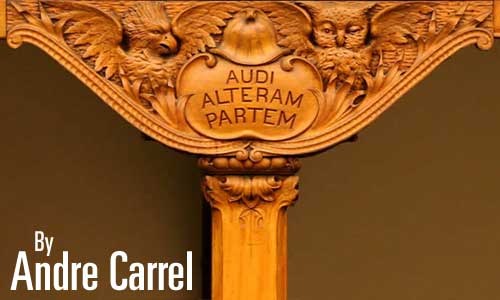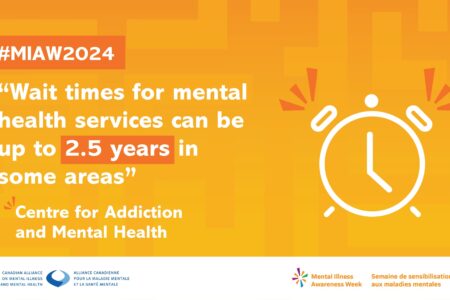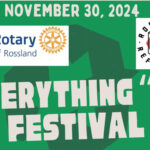OP/ED: ELECTORAL REFORM AND DEMOCRACY
Discussions on electoral reform are as persistent in Canadian politics as is their failure to achieve results. Before any decisions are contemplated on what kind of electoral system would best serve Canadian democracy, we ought to reflect on which objectives elections are to advance in a democratic society.
What is a democracy? What principles are essential to govern a society democratically? A popular belief is that the purpose of a democracy is to maximize individual choice and freedom. That is only partially true. A democratic society’s principal objective is respect for basic human rights, including the right to individual choice and freedom. To achieve this governance must be structured so as to enable it to cultivate that respect equally for society’s majority and its minorities. To simultaneously respect the right to the individual choices and freedoms of citizens who belong to society’s minorities and its majority are not compatible objectives. If government were to grant the majority an absolute right to choice and freedoms, it would by necessity have to impair the minorities’ enjoyment of these rights.
What distinguishes democracy from all other governance philosophies is tolerance – tolerance in the sense that one person’s right to individual choice and freedom may be limited to the extent necessary to secure the next person’s right to individual choice and freedom. The abiding challenge for all democratic governments is to be at once principled, equitable, and reasonable when imposing limits on the rights of individual choice and freedom. The starting point to governance compatible with democracy’s philosophy and its principal objective of respect for human rights is an election system structured to achieve that objective. To that end the election process cannot be allowed to bestow excessive powers on any one of the individuals it elects. The plurality voting system (First Past the Post – FPTP) tends to focus on the personality of party leaders, empowering these individuals accordingly. The growing practice of identifying political parties by the personality of their leader (e.g. Harper Conservatives, Trudeau Liberals), tends to overwhelm the philosophies, policies and ideas at the core of political parties. This weakens democracy because the foundation of its philosophy is ideas, not personalities.
The 2015 federal election reveals the degree to which FPTP distorts the citizens’ will. Twenty-four political parties and a number of independents participated in a contest to fill the 338 parliamentary seats; 17.5 million citizens cast a ballot. Of those, a plurality of 39.47% voted for Liberal candidates, followed by 31.89% for Conservative Party candidates, 19.71% for New Democratic Party candidates, 4.66% for Bloc Québécois candidates and 3.45% for Green Party candidates. The party choice of nearly 143,000 voters (0.81%) is not represented in parliament. FPTP resulted in striking inconsistencies in the strength of the 99% whose party choice is represented. To the Liberal Party FPTP allocated one seat per 37,664 votes, to the Conservative Party one per 56,571 votes, to the New Democratic Party one per 78,665 votes, to the Bloc Québécois Party one per 81,865 and, finally, FPTP allocated one seat for the 605,864 votes cast for the Green Party. If the Liberal Party’s voter-to-seat ratio were equal to that of the Green Party, only 11 Liberal Party members would have a seat in the House of Commons. On the other hand, if the Green Party’s voter-to-seat ratio were equal to that of the Liberal Party, 16 Green Party members would now sit in the House of Commons.
As inequitable as the House of Commons seat allocation is relative to the choices expressed by voters in the 2015 federal election, it is not as extreme as the results FPTP produced in the 1996 British Columbia provincial election. In that election 661,929 voters (41.82%) cast their ballot for the Liberal Party and 624,395 citizens (39.45%) voted for the New Democratic Party. FPTP converted this result by assigning 39 Legislative Assembly seats (52%) to the New Democratic Party and 33 (44%) to the Liberal Party. Of the remaining eleven political parties and independent candidates who contested that election, the Reform Party gained two seats on the strength of 9.27% of the votes cast and the Progressive Democrat Party, with 5.74% of the votes cast, was left with one seat. The average ratio was 21,103 votes per legislative seat. The voter-to-seat ratio for the New Democrats and the Liberals was below this average at 16,010 and 20,058 respectively. For the Reformers and Progressive Democrats the ratio was a multiple of the average at 73,367 and 90,797 respectively. 58,849 voters (3.72%) were left without representation of their political choice in the Legislative Assembly.
Fair and equal representationis not the only election criterion we need to examine. The country is subdivided into 338 constituencies (geographically defined areas). Separate ballots are produced for each constituency, showing the name and political affiliation of all candidates contesting the election in that constituency. However, the election’s product, the nation’s parliament, is organized on the basis of the elected members’ political affiliations. No other factors, not the geography of their constituency, the members’ names, their gender, their cultural or social background, their education or any other aspect that may distinguish them are relevant to the seating of members and to their voting in the House of Commons. Political affiliation is the dominant if not exclusive factor of relevance in the business of parliament. All powers identified with the governance of the country rest with the political party having elected a majority to the House of Commons.
The history of the Vancouver Kingsway constituency offers a telling example of the distortions permitted under FPTP. In 1997, the first election following the creation of this constituency, Sophia Leung, Liberal, won with 40.62% of the vote. The runner-up was Victor Wong, New Democratic Party, with 30.54%. Eight other candidates shared the remaining 28.84% of the vote. Leung, Liberal, was reelected in 2000, increasing her share of the vote to 43.07%. The runner-up this time was Alice Wong, Alliance Party, with 29.59%. Only six other candidates participated in 2000, sharing the remaining 27.34% of the votes cast. The Liberal Party retained the seat in the 2004 election with a new candidate, David Emerson, and 40.44% of the vote. The runner-up position went to Ian Waddell, New Democratic Party, with 37.27%. The remaining 22.29% went to the other six participants. David Emerson, Liberal, was re-elected in 2006, increasing his support to 43.45%. As in the previous election, Ian Waddell, New Democrat, was the runner-up. Fewer citizens, 33.5%, cast their vote for Ian Waddell in the 2006 election. Once again, six other candidates were in the running, sharing the remaining 23.05% of the votes cast.
Two weeks after the 2006 election, on February 6, 2006, Canada witnessed a striking example of just how irrelevant political parties are during an election compared to their dominant post-election role. Just two weeks after having campaigned as a member, on behalf of and at the expense of the Liberal Party, David Emerson changed his mind. He left the Liberal Party to join the Conservative Party. That party’s leader, Prime Minister Harper, immediately appointed David Emerson to join cabinet in the position of Minister of International Trade.
What did the 20,062 citizens of Vancouver Kingsway who voted for David Emerson in 2006 vote for? Did they vote for David Emerson or for the Liberal Party’s policies and campaign promises? 2006 was the fourth consecutive election in a decade in which the plurality of Vancouver Kingsway voters elected the Liberal Party’s candidate. In three of the four elections in that decade’s four elections the runner-up choice was the New Democratic Party’s candidate. Only once, in the 2000 election, did a candidate representing a right-of-centre party reach the runner-up position with 29.59% of the vote, the weakest runner-up result in any of the four Vancouver Kingsway elections. Only two independent candidates contested that riding during that period, both in 1997, together attracting a mere 0.55% of the votes cast. Kanman Wong, the Conservative candidate, attracted 18.79% of the vote cast in 2006. Would David Emerson have won the 2006 election running as an independent candidate? Would he have won if the Conservative Party had picked him as their candidate instead of Kanman Wong?
To whom was David Emerson accountable for his decision to switch political parties? Within two weeks of his election he abandoned the program he had campaigned on. Who did he now represent in the House of Commons? Had the 20,062 Vancouver Kingsway voters who cast their ballot for Mr. Emerson preferred the Conservative Party’s program policies to what the Liberal Party offered, would they not have voted for Kanman Wong? Had the 8,679 voters who supported Kanman Wong preferred David Emerson to be their Member of Parliament, would they not have voted for David Emerson? It would have required 23,143 valid votes to represent the will of the majority in Vancouver Kingsway in the 2006 election. That threshold was not reached by any party or any candidate. For David Emerson to claim that he was Vancouver Kingsway’s legitimate spokesman in the House of Commons by virtue of having been democratically elected is a sham. The issues arising from the aftermath of the 2006 Vancouver Kingsway election raise a number of serious questions on the subject of our electoral system’s efficacy. This example clearly demonstrates that our electoral system does not consider, much less respect, the voters’ choice in matters relating to the policies and programs advocated by political parties.
It is possible that the Liberal Party’s platform was preferred by some voters who made up the 43.45% plurality in Vancouver Kingsway. It is possible that some of that plurality’s voters wanted Paul Martin to be Canada’s next Prime Minister. It is possible that some voters among that 43.45% plurality wanted to be represented by David Emerson in the House of Commons under whatever terms and conditions suited him. The FPTP reality is that the right of voters is limited to voting for one of the candidates listed on their ballot. What the candidate supported by the plurality does with the trust placed in him by voters, and how he interprets their mandate, is left to his sole and absolute discretion.
The purpose of government, any government, is to exercise a directing and restraining influence over people. Democracy is unique in that it does so with the express consent of the people. No other system can make that claim. As noted, democracy’s abiding challenge is to be at once principled, equitable, effective and reasonable in its use of power. Democracy’s mandate is not to please the majority, much less a plurality. Its mandate is to ensure that governments do not violate fundamental human rights as they exercise their power. The aftermath of the 2006 election in Vancouver Kingsway is an example of how easily democracy’s philosophy can be undermined by politicians willing to abuse the FPTP process in their pursuit of power.
FPTP is less problematic in Nunavut and the Northwest Territories because the legislatures in these two northern territories are not organized on the basis of party affiliation. Candidates in these two jurisdictions run as independents. As a first step following an election, legislators elect a government leader and cabinet members from among their own ranks. The absence of political parties precludes the possibility of a conflict between loyalty to a political party and loyalty to a constituency. There is no process by which independent legislators can be “whipped” to cast their vote in compliance with party directives. Northern legislators are accountable to their constituents and no one else. Without political parties, there is no such thing as an Emerson switch. Democracy in the Northwest Territories and Nunavut could be strengthened by requiring run-off elections between the top two candidates in any riding where no candidate secured a majority of the votes cast in the first round.
Election Statistics for the past half century show worrisome trends. Canadians elected 16 parliaments in the past 50 years; ten resulted in majority governments and six in minority governments. The voter turnout ranged from a high of 76.7% in 1972 to a low of 58.8% in 2008. The voter turnout in the past half century declined steadily from an average of 74.55% in the first decade of to an average of 63.25% in the last decade. Voter turnout was but a minor factor in terms of the governments arising out of these 16 elections. The average voter turnout for majority governments was 69.88% compared to an average of 68.48% for minority governments. In contrast, a comparison of the results produced by the 1965 and 1997 elections reveals stark inconsistencies. The 1965 election with a voter turnout of 74.8% and 40.18% support for the leading party resulted in a minority government. The 1997 election with a voter turnout of 67.0% and 38.46% support for the leading party resulted in a majority government. We had three majority governments (1997, 2011 and 2015) where the leading party was endorsed by a smaller percentage of total votes cast than the percentage support extended to the party forming the minority government of 1965. The general election of 1984 was the only election of the 16 where a true majority, 50.03%, voted for the leading party. The voter turnout in this election was 75.3%.
Comparing the 2011 to the 2015 election shows just how radical a change FTPT elections can produce from the slightest change in voter preference. The difference between voter support for the parties forming majority governments in 2011 (39.62%) and 2015 (39.47%) is a mere 0.15%! A difference of only 5,735 votes is the difference in the vote spread between the first and second parties in the 2011 election (Conservative/New Democrats) and the 2015 election (Liberal/Conservative). Whether that difference is expressed as a percentage (0.15%) or in actual numbers (5,735 votes), it is astonishing that such a miniscule difference in votes could result in a contrast as significant as what distinguishes – to use the media’s terminology – a Harper Government from a Trudeau Government.
The struggle for control and absolute power made possible by FPTP is detrimental to the lifeblood of political parties. Political parties are assemblies of citizens who hold to a common belief on what society should aim for and what role government should play to that end. It is reasonable that citizens in a country with Canada’s complexities, the multitude of their cultural and linguistic histories and the diversities of their social and economic experiences would hold to a colourful range of political philosophies. The idea that such a nation could be of one mind at all times and on all subjects is absurd. How could one political party – any political party – understand and appreciate the entire population’s ambitions? The idea that one party could develop the answers to satisfy everyone’s needs and ambitions is equally absurd. Democracy’s secret weapon in this struggle is its capacity for and deference to compromise. Democracy’s strength is in the art of debating. From a nation’s multitude of fears, ambitions, views and desires to create compromise policies, solutions and projects. Compromise – not to be mistaken for surrender – is not easily achieved. A compromise is not likely to fully satisfy any one group, but when it arises out of spirited debate it will be accepted as a reasonable and appropriate solution by most. Such a debate is not possible in a parliament and cabinet where the votes are under the effective control of a single political party. A workable compromise is possible only in a parliament where no single political party forms a majority, where the many differing and conflicting political views and opinions held by Canadians are fairly, effectively and proportionally represented.
Canada would not bethe first country to abandon FPTP in favour of proportional representation. As Canada did, New Zealand had inherited FPTP from Britain. Dissatisfaction with that system grew following two successive elections in 1978 and 1981 in which the second party, with less than 40% of the vote nonetheless gained a majority in parliamentary, leaving the opposition benches to the country’s most popular party. The Labour Party promised to appoint a royal commission on electoral reform in the 1984 election campaign. The party was elected to form government and acted on its election promise in 1985 by establishing the Royal Commission on the Electoral System. The Royal Commission submitted its report Towards a Better Democracy in 1986. The government did not immediately act on the Royal Commission’s recommendation. It was in 1992 when New Zealand held its first referendum on the subject of its electoral system. Unlike the 2005 and 2009 British Columbia referenda on that same topic wherein citizens were offered a single proportional representation system to replace FPTP, New Zealanders were presented with a two-part referendum. The first part asked voters to take a stand on the current voting system:
a) I vote to retain the present First Past The Post system,
b) I vote for a change to the electoral system.
An overwhelming majority (84.72%) called for a change. The second part asked citizens to indicate their preference from a choice of four proportional voting systems. A strong majority (70.51%) voted for the Mixed Member Proportional option. Support for the other three systems on offer, Single Transferable Vote (17.37%), Single Preferential Voting (6.56%), and Supplementary Member (5.55%) was negligible.
New Zealand held a follow-up referendum in 1993 asking voters to confirm the conclusion drawn from the first referendum. Traditionalists who wanted New Zealand to retain FPTP Groups campaigned hard for their cause. The outcome of the second referendum was a surprise in view of the 1992 results. After having been rejected by nearly 85% just one year ago, 46.14% voted to retain FPTP. The majority (53.86%), however, confirmed the earlier preference for the Mixed Member Proportional system. New Zealand’s first election under the rules of that system was held in 1996, but the file was not closed with that election.
A third referendum was held in 2011. This was again a two-part referendum, identical in principle to the first electoral system referendum held in 1992. The first part asked voters to once again take a stand based on their experience with proportional elections:
a) I vote to keep the MMP voting system,
b) I vote to change to another voting system.
The referendum’s second part asked voters for their preference between the FPTP, Preferential Voting, Single Transferable Vote, and Supplementary Member systems.
The majority (57.77%) voted to retain the Mixed Member Proportional system the country had used since 1996. Support for that system had grown by 3.91% since its adoption in 1993. The results of the referendum’s second part questions were rendered irrelevant by the result of the first part. It is interesting to note, however, that the FPTP alternative had more support (46.66%) than any of the other three proportional voting systems on offer. The 30-year path from the dissatisfaction with the long-established plurality voting system to confirmation of a proportional voting system was a tortuous one, but it was eminently democratic.
Canada needs electoral reform. New Zealand has successfully reformed its system, but Canada should not adopt the Mixed Member Proportional system just because that system has proven to be a successful alternative to FPTP in New Zealand. What we should look to New Zealand for is the process by which that country replaced FPTP. New Zealand’s process was more thoughtful and thorough, and thus far superior to the process used in British Columbia. Commissions studying broad policy issues and making recommendations based on their findings have served Canada well. The 1963 Royal Commission on Bilingualism and Biculturalism and the 1974 Mackenzie Valley Pipeline Inquiry are examples of such studies which had a profound, lasting, and positive impact on the nation.
The trend in FPTP national elections over the past half century calls for consideration of alternatives to the established voting system. We should start with the appointment of a Royal Commission charged with a mandate to examine what responsibilities democracy’s philosophy attaches to elections, and to address its findings and recommendations to both the federal government and the nation.


























